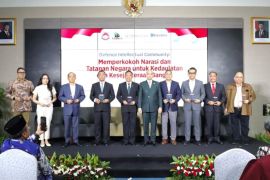He drew attention to several factors that can drive downstreaming, such as the shifting global trends wherein consumers prefer renewable and environmentally friendly products and high awareness of personal and environmental sanitation.Jakarta (ANTARA) - The Industry Ministry has put forth three strategies to downstream the palm oil-based oleochemical industry that produce goods in high demand among global consumers amid the pandemic.
"First, the expansion of production capacity and cost efficiency after the continuation of certain natural gas price policies," the Ministry's Acting Director General of Agro-Industry, Putu Juli Ardika, noted in his statement received here on Friday.
The second approach focuses on the efficiency of palm oil for the oleochemical industry through the use of industrial vegetable oil or Industrial Lauric Oil (IVO/ILO) to replace the food-grade Crude Palm Kernel Oil (CPO/CPKO) that is priced higher, he explained.
Ardika noted that in 2019, the ministry had facilitated the issuance of quality standardization for the IVO/ILO products through the Indonesian National Standard (SNI) No. 8875:2020 on industrial vegetable oil as a raw material for manufacturing green fuels.
Furthermore, the ministry has suggested industry players to commercialize the research results of oleochemical downstream products into the industrial scale, with pilot plant facilities being built at the ministry's Bogor Agro-Industry Center (BBIA).
"Stakeholders can utilize industrial services that are the pilot plants to upgrade the level of technology and manufacturing readiness," Ardika affirmed.
The pilot plants should function in a way so as not to hinder the oleochemical technology development by the processes right from laboratory-scale research to industrial commercialization, or called the valley of death phenomenon, he stated.
Indonesia is known for being a top palm oil supplier in the world. In 2020, the total national palm oil production of CPO and CPKO had reached 52.14 million tons, according to Ardika.
Palm oil processing in Indonesia is superior, as is apparent from the shift in the export volume ratio of downstream products to raw materials or crude palm oil, which is in the percentage ratio of 85:15.
Ardika explained that some 160 types of downstream products were produced domestically for food purposes, phytopharmaceuticals or nutrition, chemicals or oleochemicals, and renewable fuels or FAME Biodiesel.
"Oleochemicals are raw materials for sanitary products that several global communities need. At the onset of the pandemic, the exports of oleochemical personal wash products had increased up to 26 percent," Ardika pointed out.
Downstreaming of the palm oil industry began firstly with the issuance of Minister of Finance Regulation (PMK) No. 128 of 2011 on the determination of export goods subject to exit duties and tariffs.
He drew attention to several factors that can drive downstreaming, such as the shifting global trends wherein consumers prefer renewable and environmentally friendly products and high awareness of personal and environmental sanitation.
By prioritizing the modernity of high-performance plant-based products at affordable prices, the oleochemical industry sector has the opportunity to gain a second higher momentum for its growth, he expounded.
Related news: Pertamina develops palm oil-based jet fuel to curb carbon emissions
Related news: Small-scale palm oil rejuvenation to increase productivity: VP
Related news: Minister highlights need of innovation-based economic recovery efforts
Translator: Sella G, Kenzu T
Editor: Sri Haryati
Copyright © ANTARA 2021












